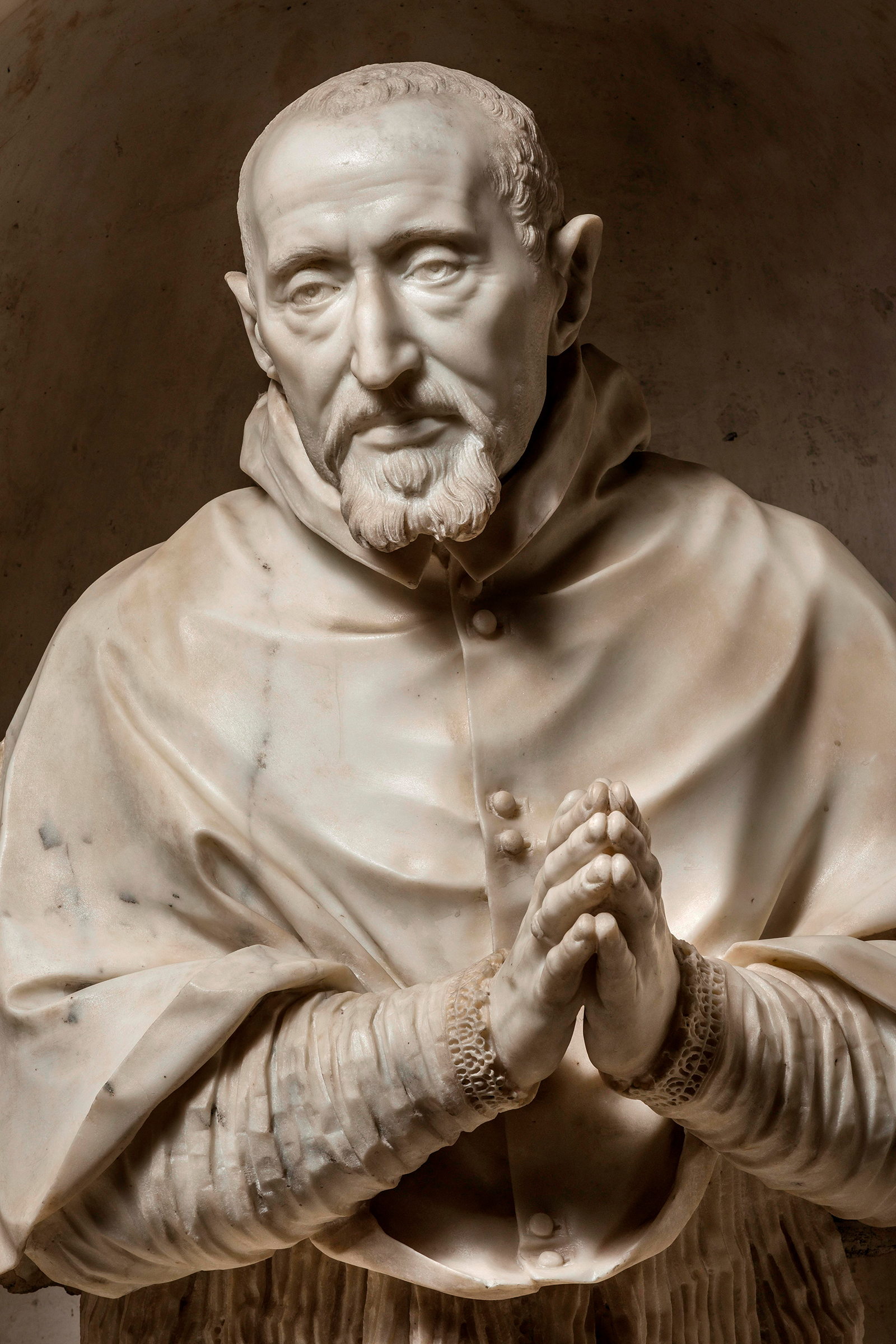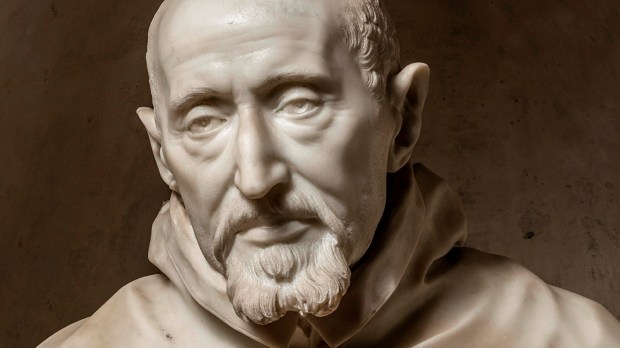Anyone who’s ever been to the Vatican knows the work of Gian Lorenzo Bernini. His colonnade surrounding St. Peter’s Square has been likened to two great arms welcoming the world to the Church. His baldachin over the main altar of St. Peter’s Basilica has been the backdrop for papal Masses and significant events over the centuries. His Chair of St. Peter is visited by thousands of pilgrims yearly.
But among his many sculptures throughout Rome is one that may not have received so much attention. It is the bust of Jesuit cardinal and theologian Roberto Bellarmino—better known to American Catholics as St. Robert Bellarmine (1542-1621). Bernini sculpted it as part of the funerary monument for Bellarmine in the Church of the Gesù, the mother church of the Society of Jesus. The monument was the beginning of Bernini’s long association with the Gesù, known formally as Chiesa del Santissimo Nome di Gesù all’Argentina. The tomb was dismantled in the 19th century and is now lost, but Bernini’s sculpture rests high above a door in the back of the church’s apse.

For the first time since it was finished in 1624, the sculpture has been allowed to leave Rome, and for a little more than three months visitors to the Fairfield University Art Museum in Connecticut, about an hour outside New York City, can stand face to face with it. It’s an opportunity to experience up close the genius of a sculptor who seems to have transformed a block of marble almost into a living being.
The bust, which Bernini worked on with his father, anticipates his conception of the “speaking likeness,” according to Linda Wolk-Simon, the museum’s director and chief curator. Contemporaries of Bernini “looked at these sculptures and felt like they were moving and stirring and turning and breathing and talking,” she said during a recent press preview at the museum. “You look at this bust and you feel that it’s not just a faithful transcription of the sitter’s appearance, but that this is inhabited. There is something internal animating the sculpture. He’s contemplative, he’s inward looking, but he’s alive.”
Wolk-Simon is the organizer of the exhibition, “The Holy Name—Art of the Gesù: Bernini and his Age,” which opened Friday and runs through May 19. Not long after Wolk-Simon came to Fairfield after a long career at the Metropolitan Museum of Art, a colleague suggested to her that it would be great if she could borrow the Bernini to mark the university’s 75th anniversary in 2017-2018. Bellarmine, after all, is the patron saint of the Jesuit university. Wolk-Simon knew it would be a long shot, but she took a chance.
She visited the Gesù several times to make her case for the loan. The church’s response “went from ‘absolutely not,’ ‘impossible,’ ‘never going to happen’ to this gradual kind of warming up,” to ultimately receiving approval to borrow the bust and four other works.
In addition, Wolk-Simon was able to borrow more than 50 artifacts from museums and private collections throughout the United States to tell the story of the Jesuits’ efforts to build their first church in Rome.
It is a history closely tied to the story of the powerful Farnese family, one of whom, Pope Paul III, had approved the foundation of the Jesuits in 1540. Paul III’s grandson, Cardinal Allesandro Farnese, funded the construction of the Gesù, which was consecrated in 1584. But the cardinal didn’t exactly give the Jesuits carte blanche. He demanded that the church have certain characteristics, such as a vaulted ceiling—much to the chagrin of the Jesuits, who feared that their preaching would get lost in such a cavernous space.
That ceiling, however, has “preached” to generations of visitors, with its fresco of a multitude of saints praising the name of Jesus, depicted by the Christogram IHS. “The Triumph of the Holy Name of Jesus” by Bernini disciple Giovanni Battista Gaulli uses a stunning trompe l’oeil effect that makes it appear that the damned are tumbling from the heavens right onto the congregation below.
Wolk-Simon could not, of course, bring the ceiling to Connecticut, but she could bring the studies that were done by Gaulli. One, a model of the apse, comes from the Gesù’s own museum; another, of the main ceiling, from Princeton University.
Around the time the Bellarmine bust was being sculpted, Pope Gregory XV canonized two of the men who founded the Society of Jesus: Ignatius of Loyola and Francis Xavier. Now the Gesù had saints of its own that it could depict in the church, and included in the new Altar of St. Ignatius was a gilt bronze sculpture of another Spaniard canonized that day, Teresa of Avila. The sculpture, by Ciro Ferri, is in the exhibition.
Also from that altar, on loan to Fairfield is a highly ornate three-piece jeweled cartegloria, which held key texts of the Latin Mass for the priest to read. In addition, there is an embroidered chasuble of Cardinal Farnese, with intricately intertwined threads of silk, gold and silver depicting the Litany of the Blessed Virgin Mary and scenes from the life of Mary.
The chasuble was no longer in use by the time Jesuit Father John W. O’Malley went to Rome to study. But plenty was still on display for him to meditate on when he visited the church. For a time, he lived right next door.
“One thing that’s true of the Gesù, as is true for all Baroque art, it’s a vision of heaven and it’s a great vision of the dignity of the human body and human beings, so sensuous and fleshy, a lot of it,” he said in an interview. “So it makes me feel happy to be a human being, to be created in God’s image. That’s one of the foundation assumptions of baroque art.”
Father O’Malley, who is University Professor in the Theology Department at Georgetown University and who served on the exhibition planning committee, agreed that the amount of artwork in a church like the Gesù gives the visitor plenty to choose from for meditation. “Some would say it’s overwhelming, it’s too cluttered,” he said. “But on the other hand it gives you a wealth. And again, it’s the magnificence of God, really. It just goes on and on an on.”
Some of that now, for a short time, can be appreciated at a museum in Connecticut.
The Fairfield University Art Museum has upcoming lectures in conjunction with the exhibition. More information is available at its website.

